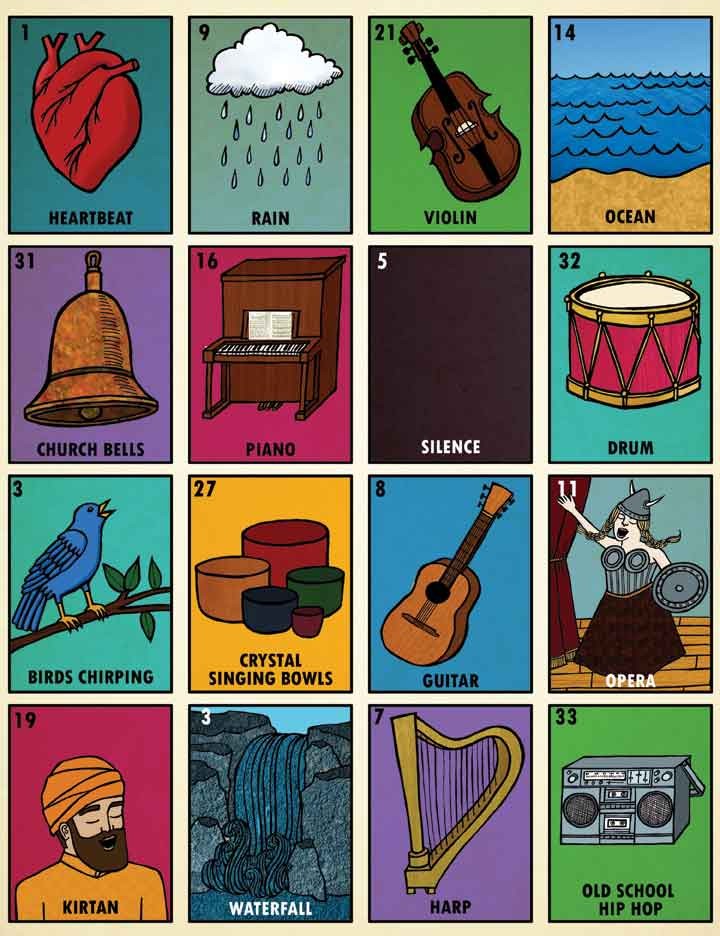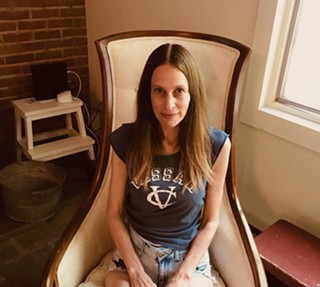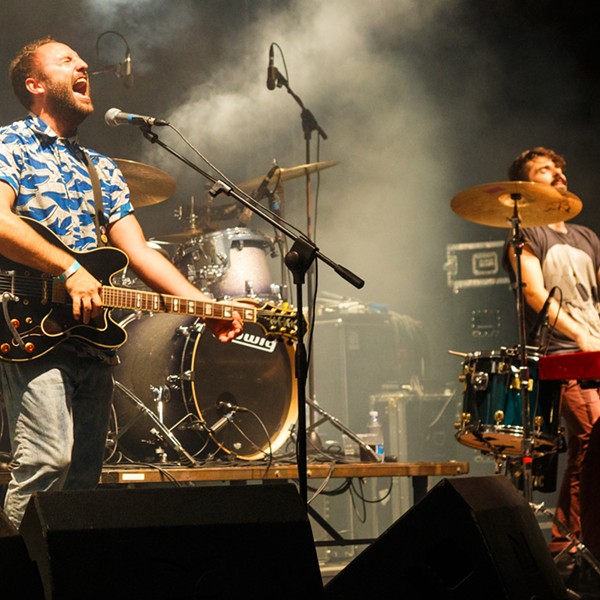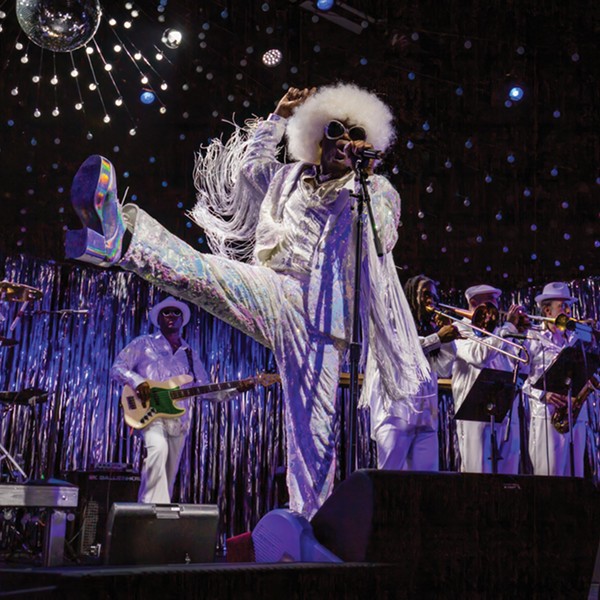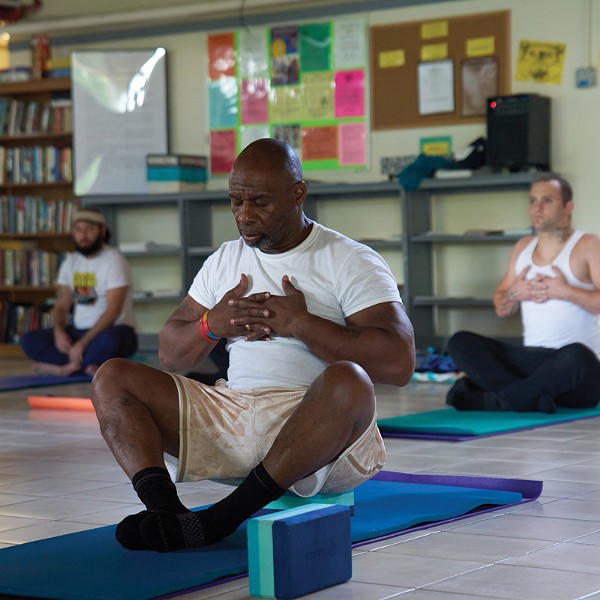On a recent car ride, my two-year-old daughter made it clear to me that she wanted to be just about anywhere else than strapped into a metal box and hurtling down US Rt. 28 at 45 miles an hour. Amid her cries, I slid Elizabeth Mitchell’s Sunny Day
Ever since people have had the ability to record sound, we’ve bottled up soothing rhythms to uncork at just the right moments—piano sonatas, rain showers, bird songs, a heartbeat, ocean waves lapping the shore. We hardly need science to prove what we already know: Certain sounds wash over us like a balm, relaxing and restoring and sometimes transporting us to another dimension entirely, beyond daily pressures and proliferating to-do lists.
Yet many musicians, healers, doctors, and scientists are taking a closer look at the way sound works to shift our awareness and even change our biodynamics to bring about healing. The arts of sound healing and music therapy, alongside participatory practices like kirtan chanting, have gained a toehold in the Hudson Valley, and not just among bearded yogis and self-proclaimed energy workers.
Dr. John Beaulieu—a board-certified naturopathic physician and licensed counselor based in Stone Ridge—has written about the therapeutic applications of sound in his own books and for the peer-reviewed Medical Science Monitor. Like a mad scientist in the music studio, Beaulieu—who is also a classically trained pianist—has conducted various experiments in search of a holy grail: the most calming sounds on Earth. Some of these are nearly universal, while others are more subjective. “I have used Guns ‘n Roses and had it be healing,” says Beaulieu. “It just depends on how it’s received.”
Sound Science
Pop music references aside, Beaulieu can tell you all about the way that different sounds and musical intervals can affect the firing of neuron synapses in the brain, the release of theta brain waves, and a host of other effects. The tuning fork—an acoustic resonator with a U-shaped metal prong—is his medium of choice for relieving stress, breaking negative thought patterns, and various other uses grounded in neurological research in sound.
Beaulieu practices both music therapy and sound healing—yet he’s careful to make a distinction between the two. Music therapy is licensed and regulated and comes with psychiatric training, while sound healing is wide open to anyone who feels called to be of service with a crystal bowl or didgeridoo. There’s a place for both, Beaulieu believes. “I don’t think sound healing should have the same rigor as music therapy. People playing crystal bowls with the right intention can do just as good work.” Yet Beaulieu cautions that sound healers should know their limits. They might not be able to recognize when someone is depressed, or they might make bold claims that they can cure cancer. “There’s a difference between curing and healing,” says Beaulieu, who notes that to heal is to help a person feel whole and complete, with a union of mind, body, and spirit.
The world of Western medicine could use more healing practices—and thankfully it’s starting to do just that. Beaulieu mentions Dr. Mitchell L. Gaynor, an oncologist and clinical professor of medicine at the Weill-Medical College of Cornell University in New York, who supervises singing-bowl sessions in a hospital setting for cancer patients and has documented cases in which cancer treatments work better alongside these integrative practices.
Placebo effects? Bring them on. “If people believe they are going to get better, their bodies will create the chemicals necessary both to cure and heal,” says Beaulieu. “We think it’s based on a molecule called nitric oxide, a neurotransmitter. Certain tuning forks create this immediately in the brain stem.” While it’s clear that Beaulieu loves the science behind the music, he’s also wistful about letting the intellect go so the sound can do its medicine-man work. “You can never get rid of your license,” he says with a laugh.
Rhythm Doctor
“Sound healer” is a heavy mantle to put on anyone, but Philippe Garnier wears the garment with an easy grace. When I arrive for my session at Sage Center for the Healing Arts in Woodstock, which Garnier co-owns with his wife Lea, I find the French-born healer sitting in a light-filled suite of rooms with objects of beauty everywhere—crystals, feathers, drums, herbs, and clusters of Tibetan and crystal singing bowls waiting to be played.
Garnier explains that the session will begin with a sound bath—a private concert in which he serenades me with the bowls until I reach a meditative theta-brain-wave state. “The mind is shut off by the sound, and I can work on the auric field,” says Garnier. Despite years of yoga I’m a tightly wound girl, not a great candidate for hypnosis. But after several minutes of ethereal music I feel pleasantly groggy—ready for Garnier to perform his “scan.” He’s not really looking at my body; rather, he’s listening. “All disease is dissonance,” he tells me before the session. An organ can be in dissonance with the rest of the body; his job is to hear it and then, via tuning forks and other instruments, encourage the wayward sound back into harmony.
When a cough jolts me midsession, Garnier is waving a pronged, handlike instrument over my belly and striking it to produce bell-like sounds. I’m suddenly aware of how strange this is. I haven’t told him that I’m the daughter of three generations of medical doctors; I think I hear my grandfather chuckling from on high. “Your D and E notes are weak,” he says, waving a hand over my abdomen. Toward the end of the treatment, Garnier is quietly chanting mantras over me, followed by a flutter of feathers (he tells me later they’re from a condor, to “sweep my energy fields clean”). The gesture feels sweet, nurturing, and resonant of shamanism and the Peruvian rainforests, where Garnier has trained extensively with Amazonian curranderos.
Now he passes on the good vibrations to people like Robin Lane of Woodstock, an interfaith minister and psycho-spiritual counselor who started seeing Garnier after she was diagnosed with breast cancer in early 2010. “The sounds seemed to penetrate my body and move energy, pain, discomfort, and toxins,” says Lane, who credits Garnier in large part for her healing and recovery, and continues to see him for a monthly “tuning.”
Over bagels and soup after my session, I ask Garnier what he tells skeptics. “Everyone believes in music,” he says. “But even clients who say they’re not sure the session did anything for them—even they come out with a sense of wonder and peace.” I see what he means. The thought passes over me that as a culture we’re starved for ritual and ceremony, especially when it comes to our health. In a fluorescent-lit hospital, it’s hard to make meaning and feel connected to something larger than ourselves. For Garnier, it’s about letting the mind go—including doubts—so divine sound can coalesce body, mind, and spirit.
The Bhajan Belt
Some believe that the most potent instrument for sound healing is your own voice. Just ask one of the many practitioners of kirtan, or call-and-response Sanskrit chanting, which has in recent years crossed over from an ashram-based spiritual practice to a more mainstream pastime thanks to the runaway popularity of yoga in the West. Nowadays you don’t have to travel 8,000 miles to India to attend one of these ecstatic, all-inclusive musical evenings; just pop into your local yoga studio.
The embrace of kirtan and bhajan (Indian devotional chanting) is so strong in the Hudson Valley that the area has taken on the moniker “the Bhajan Belt.” It was local kirtan walla Shyamdas and Mike D of the Beastie Boys who coined the nickname, which surfaced in a New York Times article in 2002. The Saugerties-based Shyamdas, who began studying devotional chanting in the 1970s with Indian guru Neem Karoli Baba, was instrumental in bringing kirtan to the American yoga scene in the mid-1980s. “The Hudson Valley has always attracted seekers,” says Shyamdas. “I find it amazing that you can attend a kirtan pretty much every night of the week here.”
When the local duo Sri Kirtan is in town, the area’s community of dedicated chanters comes out en masse. With Ishwari on vocals and acoustic guitar and ShrutiRam on vocals and harmonium, each chant picks up from a gentle beginning to reach higher levels of jubilant energy. “Kirtan takes you out of your head and into your heart,” says Ishwari, who started her career as a punk rock singer out of Austin in the 1970s and went on to perform and study such disparate forms as electronic music, dance music, and opera. It was the divine mood created during kirtan, known in Sanskrit as bhava, that really drew her in. “My heart is 100 percent changed from doing this. I’m a much softer person.”
There’s no getting around the fact that kirtan grows from Hindu roots; the names of such deities as Ram and Shiva form the core of each chant. Yet the practice is all-inclusive. “You don’t need to adhere to any particular philosophical viewpoint,” says ShrutiRam, who like Shyamdas studied with Neem Karoli Baba. “Kirtan doesn’t have to be a devotional practice; it’s a joyful experience. You can be an agnostic or even a total atheist and you can still feel the energy.”
Considered the father of Woodstock kirtan, ShrutiRam once led weekly chant gatherings in his home, but a surge in popularity led him to seek a larger location (now Yoga Monkey on Rt. 212). More than anyone, he has witnessed kirtan’s transformative effects on a local and personal level. “People come in like overcooked spaghetti—all wilted and tired and sad. Before long they’re dancing and singing, and by the end they’re so happy to relate to each other,” he says. “It’s a scientifically proven fact that when people sing together the neurons and receptors in the brain that create separateness stop firing and a sense of unity is achieved. That’s where the healing comes in.”
Sound Immersions
Two upcoming events offer deeper explorations in kirtan chanting and sound healing. The Omega Institute for Holistic Studies in Rhinebeck presents “Ecstatic Chant: The Yoga of Voice,” May 6-8, with a lineup of luminaries including Sri Kirtan and Shyamdas (www.eomega.org). And Menla Mountain Retreat in Phoenicia will play host
June 2-5 to the area’s first “Sound Healing Retreat Intensive” with Philippe Garnier, John Beaulieu, and other leaders in the field (www.sagehealingcenter.org).







